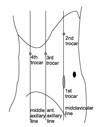Abstract
Purpose
Ureter stones are the most common urological disease. The principal objective of this study was to evaluate the results, efficacy, and safety rates of laparoscopic ureterolithotomy for the treatment of large, upper ureteral stones.
Materials and Methods
Between April 2006 and February 2008, we conducted laparoscopic ureterolithotomy in 7 patients with upper ureter stones (L2-3). Laparoscopic ureterolithotomy was conducted in 5 patients as a salvage procedure after failed shock wave lithotripsy, in 1 patient as the primary procedure for a large stone (28mm), and in 1 patient for treatment of a radiolucent matrix stone. Laparoscopic ureterolithotomy was conducted via a transperitoneal approach. The mean stone size was 20.7±5.9mm.
Results
Laparoscopic ureterolithotomy was successful in 7 patients, and none of the patients required an open procedure. All patients were rendered stone-free after a single procedure. The mean operative duration, mean postoperative hospital stay, and mean estimated blood loss were 142±49 min, 6±2.2 days and 85±29.5ml, respectively.
Conclusions
Although the majority of patients with ureter stones can be rendered stone-free via shock wave lithotripsy and endourological procedures, open surgery is required for large and upper ureter stones. In cases of large and upper ureter stones, laparoscopic ureterolithotomy may be considered for a limited group, although many will require open surgery.
Figures and Tables
 | Fig. 1Patient with 28mm right-sided upper ureter stone. (A) Preoperative plain film. (B) Postoperative film showing no evidence of residual stone and stenting ureter catheter. |
References
1. Keeley FX, Gialas I, Pillai M, Chrisofos M, Tolley DA. Laparoscopic ureterolithotomy: the Edinburgh experience. BJU Int. 1992. 84:765–769.
2. Paik ML, Resnick MI. Is there a role for open surgery? Urol Clin North Am. 2000. 27:323–331.
3. Paick ML, Wainstein MA, Spirnak JP, Hampel N, Resnick MI. Current indications for open stone surgery in the treatment of renal and ureteral calculi. J Urol. 1998. 159:374–379.
4. Chaussy CG, Schmiedt E, Jocham D, Brendel W, Forssmann B, Walther V. First clinical experience with extracorporeally induced destruction of kidney stones by shock waves. J Urol. 1982. 127:417–420.
5. Bierkens AF, Hendrikx AJ, De La Rosette JJ, Stultiens GN, Beerlage HP, Arends AJ, et al. Treatment of mid- and lower ureteric calculi: extracorporeal shock-wave lithotripsy vs. laser ureteroscopy. A comparison of costs, morbidity and effectiveness. Br J Urol. 1998. 81:31–35.
6. Arrabal-Martin M, Pareja-Vilches M, Gutierrez-Tejero F, Mijan-Ortiz JL, Palao-Yago F, Zuluaga-Gomez A. Therapeutic options in lithiasis of the lumbar ureter. Eur Urol. 2003. 43:556–563.
7. Wu CF, Chen CS, Lin WY, Shee JJ, Lin CL, Chen Y, et al. Therapeutic options for proximal ureter stone: extracorporeal shock wave lithotripsy versus semirigid ureterorenoscope with holmium: YAG laser lithotripsy. Urology. 2005. 65:1075–1079.
8. Kwon YU, Lee SI, Jeong TY. Treatment of upper and mid ureter stones: comparison of semirigid ureteroscopic lithotripsy with holmium: YAG laser and shock wave lithotripsy. Korean J Urol. 2007. 48:171–175.
9. Sfaxi M, Miladi M, Ben Hassine L, Jemni M, Chebil M, Ayed M. Treatment of ureteral stones by ESWL. Indications and results in 201 cases. Prog Urol. 2003. 13:50–53.
10. Perez-Castro Ellendt E, Martinez-Pineiro JA. Transurethral ureteroscopy. A current urological procedure. Arch Esp Urol. 1980. 33:445–460.
11. Keating MA, Heney NM, Young HH 2nd, Kerr WS Jr, O'-Leary MP, Dretler SP. Ureteroscopy: the initial experience. J Urol. 1986. 135:689–693.
12. Byeon SS, Jeon SS, Lee HW, Park EC, Lee JH, Kwak C, et al. Ureteroscopic manipulation for ureteral calculi: comparison with ESWL. Korean J Urol. 1996. 37:1124–1131.
13. Raboy A, Ferzli GS, Ioffreda R, Albert PS. Laparoscopic ureterolithotomy. Urology. 1992. 39:223–225.
14. Gaur DD. Laparoscopic operative retroperitoneoscopy: use of a new device. J Urol. 1992. 148:1137–1139.
15. Lee YS, Lee DH, Han WK, Kim HJ, Yang SC, Rha KH. Laparoscopic ureterolithotomy has a role for treating ureteral stones. Korean J Urol. 2006. 47:498–501.
16. Park HK, Oh SJ, Kim HH. Laparoscopic retroperitoneal ureterolithotomy. Korean J Urol. 2002. 43:287–290.
17. Skrepetis K, Doumas K, Siafakas I, Lykourinas M. Laparoscopic versus open ureterolithotomy. A comparative study. Eur Urol. 2001. 40:32–37.
18. Goel A, Hemal AK. Upper and mid-ureteric stones: a prospective unrandomized comparison of retroperitoneoscopic and open ureterolithotomy. BJU Int. 2001. 88:679–682.
19. Kijvikai K, Patcharatrakul S. Laparoscopic ureterolithotomy: its role and some controversial technical considerations. Int J Urol. 2006. 13:206–210.
20. Gil G, Kim KS, Koo DY, Shin JH, Kim JK, Sul CK, et al. The result of laparoscopic radical nephrectomy conducted by the single surgeon. Korean J Endourol. 2007. 6:115–122.
21. El-Feel A, Abouel-Fettouh H, Abdel-Hakim AM. Laparoscopic transperitoneal ureterolithotomy. J Endourol. 2007. 21:50–54.
22. Flasko T, Holman E, Kovacs G, Tallai B, Toth C, Salah MA. Laparoscopic ureterolithotomy: the method of choice in selected cases. J Laparoendosc Adv Surg Tech A. 2005. 15:149–152.
23. Hemal AK, Goel A, Goel R. Minimally invasive retroperitoneoscopic ureterolithotomy. J Urol. 2003. 169:480–482.




 PDF
PDF ePub
ePub Citation
Citation Print
Print






 XML Download
XML Download